
DIVING IN THE MOON
HONORING STORY, FACILITATING HEALING
Why I Keep At It
© Joan Stockbridge
I stumbled into the therapeutic use of storytelling almost 20 years ago, when I was asked to tell stories to women in a domestic violence shelter. After telling a Scottish story, I was shocked by the tumultuous conversation that followed.
“I’m like her, lost everything while I was knocked out.”
“Drugs were the cliff I fell off of.”
“My ex is the fairy king. He stole my kids.” And then, weeping, “I’ll never give up.”
The energy, the rawness, and the honesty of that conversation moved me deeply, along with the profound longing the story had surfaced. I sensed that the story was a lifeline the women had grabbed on to, and it had somehow pulled them up out of confusion, trauma and despair.
That storytelling session was an awakening. I immediately began to explore the intentional use of story for healing. I discovered the Healing Story Alliance, Alida Gersie’s work, Allison Cox’s Healing Heart books, and the invaluable conversations on the HSA listserv. I took workshops at storytelling conferences. Mostly I learned through experience. I volunteered weekly at the shelter. I was invited to offer brown bag lunches for the county mental health staff and subsequently to co–lead groups. I found myself at an empowerment program for homeless women and also leading groups for court-mandated women in substance abuse recovery.
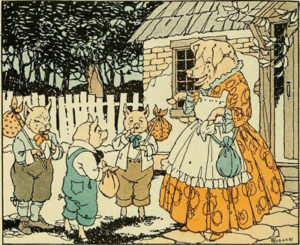
I’ve been volunteering in the homeless program for 16 years and at the treatment facility for 14 years. I’m fortunate to have had the time to volunteer. At one point, I was close to burning out. And then I went to a crisis nursery, where young children and infants are taken if they have to be removed from their homes. I led the kids into the back yard where three playhouses were set up.
“Perfect,” I thought, “Let’s do the Three Little Pigs.” So I narrated the story and the whole herd of children ran shrieking from house to house.
“Be brave. Be fast, little pigs,” I urged. “Stick together.” They insisted we do the story over and over, taking turns being the wolf.
Time was up, and they were called in for lunch. But the group leader, a boy of about 5, came up. “Will you be our mother?” he asked. I was stunned. He stared into my eyes. The other kids were hanging by his side, their eyes fixed on mine. “We’ll be good,” he said. “We’ll hold hands when we cross the street.” The kids all gripped hands. “We’ll fight off bad guys,” He karate-kicked, and the others followed suit. “We’ll take naps whenever you tell us to.” All the kids lay down on the grass.
My heart was breaking. I felt an immense, unbridgeable divide. I could not be their mother. But inspiration came. “I am your story mother,” I said.
“And we’re your story children,” he said. “See you later!” And they all waved goodbye.
It was good the social worker came out just then. Tears were running down my face. I leaned over, picking up my backpack as the kids ran happily into the kitchen.
What I learned again, that day, is that the power of story is real. A story cannot solve addiction or provide a safe home. But a story can awaken sources of hope and healing, can connect us to wellsprings of renewal, can renew our vitality and lift our spirits. In short, story can help us live courageously in all situations. Stories can awaken us to truths that external circumstances would deny.
We are on a heroic journey; all we need are the eyes to see it, the heart to desire it, and the will to live it. Stories can empower all three.
Write Up of a Healing Story Session
It’s difficult to communicate the intimacy and power of a healing story session, but I’m including these notes in an attempt to evoke the atmosphere. These notes are taken from a session several years ago at a residential drug treatment facility for women. The women are primarily court-mandated into this program, and they also have open Child Protective Services cases. During this session, two residents were away at appointments. The women were tense because a resident had just been expelled for smuggling in drugs.
Check In
M described herself as “tripping” about her guy, who is always on her mind, addicted, going to jail, and the father of the child she is pregnant with.
D arrived two weeks ago. When I asked what she had learned about herself so far in the program she said that she now knows she comes from a family of alcoholics, including her 86 year old mother who lives with her.
K is stressed out because she has been warned she might permanently lose custody of her two children.
M2 arrived in the program yesterday. She is pregnant and was life-flighted from Portola because of hemorrhaging. She had used meth the night before and tested positive at the hospital. She was discharged from the hospital to the program. She has never been in a rehab program and said she liked the other women who were very nice to her and gave her clothes and toiletries.
Story and Follow Up Conversations
I told Lady Janet and Tamlane. (My version is based on Jane Yolen’s version, Burd Janet, found in Not One Damsel in Distress.) During the story there was visible relaxation. The women sprawled on the living room couches. D nursed her baby. It was clearly a very welcome and healing respite from the tension of the day.
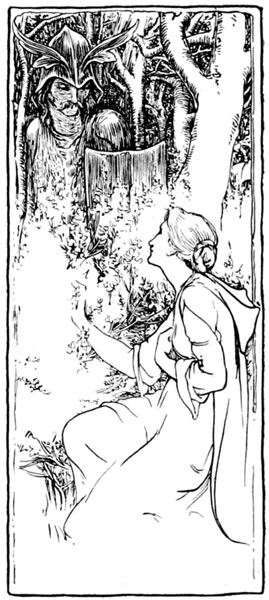
After the story, I asked what stood out in the story for them. M talked about the dark fairies and also about letting go, how she liked when Lady Janet finally let go of the burning stick into the well. “Does that remind you of anything in your life, something you might have talked about during check in?” I asked.
“OMG,” she shrieked, “it would be like me letting go of obsessing over my guy!” D talked about how Janet had taken control of her life, which she liked and was trying to do.
Story Focus
After the general conversation, I drew their attention to two moments in the story.
- Lady Janet returning to reclaim the family home after it was occupied and ruined by the dark fairies. I compared this to reclaiming one’s wholeness after trauma.
- Lady Janet holds on to Tam Linn throughout his enchanted transformations to serpent, lion, and fire. I compared this to holding on to recovery despite triggers and challenges.
Story-Based Activity
We moved from the living room to the adjacent table. I handed out copies of a picture of Lady Janet standing on the threshold of her ruined home and challenging the dark fairies to leave. (This was a copy of the black and white picture in Not One Damsel in Distress.) I asked them to look closely at the image and tell me what they saw. They noticed the shadowy images of the fairies, and I asked if they could think of any shadowy threats to their health and wholeness. This led to a lively and honest discussion about addiction, bad relationships, and a history of bad choices. I asked them to imagine themselves in the picture, confronting their “inner demons” in order to reclaim their true selves and then to write something in response. I said they could journal about the story, or write a letter to a character in the story, or just free write about what the story or picture was bringing up for them.
This is what K wrote in response.
Dear Lady Janet,
Taking a look at this picture I felt what you have shown me today in the story. The hidden faces and the two sides are my two consciences. One that tells me to do right and one that tells me to do wrong. You represent myself, standing in the middle, ready to walk away from those who love me. Today I was feeling like leaving, afraid of losing my kids and just wanting to run away. But knowing I need to stay because I am taking steps to better myself for my kids. So it leaves me stuck in a place where I don’t want to be, like you in that doorway. They took your house. What has been taken from me is my self esteem so I want to reclaim who I truly am, a person of my word. So Janet, thank you so much for providing this photo. It almost feels like a spectator took a picture of me today because I am going to make the effort to continue my program no matter how much it hurts. ~ Always, K.
How Happiness Came
I use this warm-hearted story from the Saami people in many settings. Focusing on positive memories helps create pathways to relieve anxiety and alleviate trauma symptoms. Perhaps even more importantly, such memories and stories provide immediate uplift and foster connection within a group. After telling this story, I may ask “What makes you happy?” or “What undermines your happiness?” I often invite group members to quickly brainstorm a list of “sweet moments” in their lives and then to write each moment as a phrase on a slip of colored paper – for example, “singing birds by the marsh.” I give everyone a container (shoe box, basket from the Dollar Store, gift box, even a decorated brown lunch bag) to put their slips into and use as a Happiness Holder. I encourage everyone to continue to add memories to their Happiness Holders and also to draw a slip daily.
This is how it was:
One day Akanidi, Bright Sunbeam, Daughter to the Sun, was flying through the heavens gazing down at earth. Her warm rays touched the reindeer, the fish, the fox. She understood all the animals and brought them happiness. Only people were beyond her comprehension. Sometimes they gazed up at her and smiled. Sometimes they hid behind their tent flaps.
By what laws did people live?
What made them laugh?
What made them cry?
Why were they sometimes cruel?
Why was there so little beauty in their lives?
As Akanidi gazed at the earth, she felt sorry for people and wanted to bring them happiness that would never leave them.
As evening approached, and the Sun sank down beneath the sea to rest, his daughter approached him.
“Let me descend to earth, Father.”
“Descend to earth! Have you not space enough in the sky?”
“I am tired of the sky. I want to live among people.”
“But you have the clouds to play with, the sunbeams to dance with, the wind to sing with,” said the Sun. “People are strange and often cruel. And the dark-hearted marsh witch, Oadz, lives there. She hates light.”
At first Akanidi was silent. Then she pleaded again.
“Please Father. Just for a short while.”
The Sun gazed on his bright daughter. He did not want to lose her, but he could see the power of her desire.
“Very well, but just for a short while. Go to sleep and rest now.”
When Akanidi woke, she was lying in a human dwelling. An old man and old woman were gazing at her, astonished. They had no children, and now, in front of them, in their tent, lying on their reindeer hide, from out of nowhere, was a young girl. Her face was as round and rosy as a cloudberry. Her eyes, staring warmly at them, were as blue as the sky. “Let me live with you,” she said.
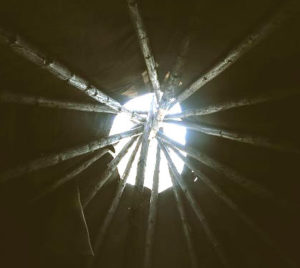
The old woman was wise, and she could guess what kind of miracle this was. “We would be honored to have you as our daughter. Please live with us.”
So the Sun-Maiden began to live with human folk. She soon discovered that her father had placed her with the old man and woman because they lived on a little island in the middle of a great lake, and there was not another human soul around. Thus her father sought to keep her safe. But this was not what Akanidi wanted, and she began to plead, “Please, let me go play with the other young people. Let me go to shore.”
But the old woman always answered. “You are too young to even wear a maiden’s dress. Be patient, my girl, your time will come.”
So Akanidi was patient. She helped the old woman around the tent. She helped the old man mend his nets. In the evenings she watched the old woman patiently working the tough reindeer hide, making a maiden’s dress. Akanidi began to stick on dried berries in beautiful circles, glistening stones in antler patterns. “It’s so pretty!” the old woman exclaimed. “I’ve never seen anything like it.”
Finally one day the old man made a crown from juniper twigs and old woman dressed Akanidi in her maiden’s dress. How happy she was! She sang a merry song, danced a little dance, and beamed with joy. The old man and woman gazed at her and marveled at her sweet voice; it was like birds singing and wind sighing, like leaves whispering in the trees. And their hearts became joyful.
“It is time to take you to the people,” the old man said. “May you open their eyes and ears, Akanidi. May your heart remain full of kindness and soften the people’s hearts.”
That night a strong wind blew the little island northwards across the lake and to the mouth of the river. When Akanidi woke, the little island was touching the shore. She put on her maidens dress, took her little leather pouches of stones, and then she and the old couple stepped onto the land and went to meet the people.
They arrived at a camp, raised the flap of the nearest tent, and saw a Saami family sitting around the hearth, eating whale meat. The fat dripped down their fingers, and they grinned with pleasure. That year the sea had been good to them, sending an ice mountain with a whale frozen in the center, so they had fed well all winter.
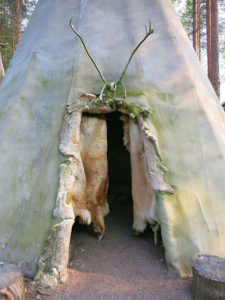
When Akanidi entered the tent, the Saami folk sprang to their feet. Never had they seen such bright blue eyes, such a rosy sweet face, such a beautiful dress. The women started to press their cheeks against hers; the men stroked her braids; the children tugged at her dress. Then Akanidi said one mysterious word, and suddenly, though she stood still, no one could touch her. Their hands passed right through her, as though through thin air. The women were frightened, the men puzzled, and the children began to cry. But Akanidi laughed, took the smallest child by the hand, and told everyone to follow her to the river-bank. There she sang songs and told stories for them.
Never had the Saami folk seen or heard the like. Their eyes and ears were opened and such a great joy flooded their hearts that they took up the song and began to swirl about in a dance. When everyone had sunk to the ground in exhaustion and no one was looking, Akanidi opened a little bag and placed stones on the ground. “Come see what’s under my hand.”
The young people sprang up. “What could be there? There’s nothing here.”
“Oh, yes there is.” And the Sun Maiden lifted her hand and there before them on the ground lay beautiful patterns—rings within rings, branching antlers, magpie feet, reindeer tracks—all in stones that glistened in the sunlight. “Now make patterns yourselves.”
The young people did their best, carefully piecing together little stones and berries, with Akanidi just touching them here and there, to make the patterns even prettier. Everyone’s heart was filled with joy, and the young women, and men too, spent their days decorating boots and clothing, pleased at the beauty they were creating.
Meanwhile, Akanidi wandered from tent to tent, camp to camp, settlement to settlement. In one place she would cut a hollow stem and make a flute from it. In another she would sing a song or do a dance. And everywhere she taught the people how to make beautiful patterns.
The Saami people began to live in happiness; joy was in their hearts. They dressed gracefully and sang and played and danced. When they mended their nets, herded their reindeer, or journeyed in sledges, they sang the songs Akanidi had taught them—songs of the sun and the sea, song of the ice mountain that had brought them whale meat, songs of good fortune. And as evening drew in, they would gather in a circle and sing and dance together.
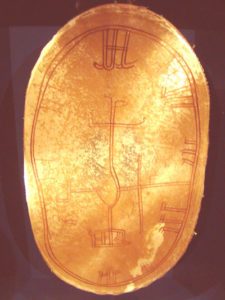
Only the old ones were not warmed by Akanidi’s love. Their eyes remained closed to the beauty of her patterns; their ears shut to her songs and stories; their hearts cold to her kindness. They stared at the lovely stones she brought and shouted, “Bring us more!” When Akanidi brought more glistening stones, they shouted again, “Bring us more!” Soon the Sun Maiden realized that they did not want the stones for beauty or joy, they wanted the stones to trade for furs and meat, so that they could sit in their tents in idleness.
So Akanidi told them, “I shall bring you no more gems.”
Then they grew spiteful and cruel.
“What are those dances and songs and patterns? The Saami folk never knew them before. We must get rid of Akanidi. She is turning us away from the ways of our fathers.” So, the old ones went down to the dark swampy marsh to bring the black-hearted witch Oadz, she with the toad’s paws, out of the slime. They brought with them a reindeer carcass, and when the witch smelled the rotting meat, she rose up from the ooze. She had long waited to get rid of the Sun Maiden, for the Saami people no longer brought her offerings. So she took the reindeer carcass and told the old ones,
“Take a moss-green stone, go to Akanidi in her tent and close the smoke hole so the Sun cannot see her. Then kill her with the stone.”
So the old ones found a moss green stone. They found Akanidi in her tent, showing the children how to make buttons out of shells. They were in such a hurry that they forgot to block the smoke hole; they threw the stone hard at Akanidi and hit her full force in her chest, right at her heart. But a strange thing happened; at once she faded almost clean away, sighed deeply, then sang out one last song. In the half dark her song beat its wings against the tent like the beating of a giant drum, and the Saami people, listening, felt their souls rise up aloft, lifted by the gratitude they felt for the kind Sun-Girl. As the song came to an end, Akanidi flew up to the sky in the spiraling fire smoke.
Never again did she descend to earth. Yet her songs remained, her dances remained, and her lovely patterns remained. The Saami folk remember them and pass them on to the young ones. It is then that eyes and ears open, hearts soften, hands create beauty, and happiness comes.
All that I have told you is true, as true as the Sun’s path across the sky, as true as day following night, as true as the change of winter to summer. And that it may continue to be true, may your eyes and ears open, your hearts soften, your hands create beauty, and happiness will come.
Adapted by Joan Stockbridge from “How Happiness Came” – found in The Sun Maiden and the Crescent Moon: Siberian Folk Tales, collected and translated by James Riordan, Interlink Books, Edinburgh, 1989.
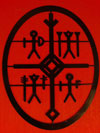

Joan Stockbridge tells stories in unlikely places, such as rehab clinics and homeless shelters, as well as the usual kinds of places, such as schools and concert stages. She tells traditional, historic, and original stories and likes to listen to stories too. She received the National Storytelling Network’s Oracle Award in 2016 for service and leadership through story in the Pacific region. She is also a spiritual director and retreat and workshop facilitator. Contact her at www.joanstockbridge.com.
